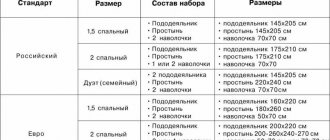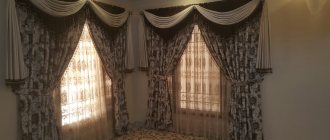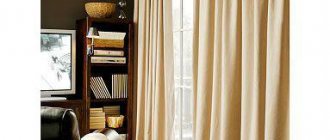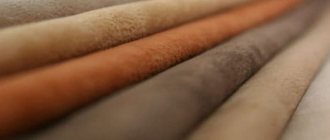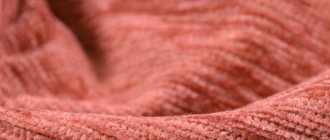Making your own bedding is the best way to get sleep accessories in the right colors and the perfect size. To successfully cope with this task, you do not need to be a professional seamstress - just carefully study the instructions and strictly adhere to them. And the first thing you need to start with is to calculate the fabric for a set of bed linen without errors, so that there is enough linen and there are no extra pieces left. And this is not difficult to do if you know exactly what size pillows, mattress and blanket you need to “dress”.
Do I need to consider the type of fabric?
To make a perfect set of sleeping accessories, it is not enough to make the pattern correctly and carefully sew the seams. The result of the efforts largely depends on what material was chosen. When calculating how much fabric you need to buy for a set of bed linen, it is important to take into account its main characteristics:
- Naturalness . Synthetics are the worst things you can buy for sleep accessories. Preference should be given to natural materials that absorb moisture well, allow air to pass through in the summer and retain heat in the winter. Bedding made from synthetic fibers does not allow the skin to breathe freely at night, which means that sweat does not evaporate from its surface, causing diaper rash and allergic reactions. As a last resort, you can buy a material with a mixed composition of cotton and polyester, but the latter should be no more than 30% so that the quality of the fabric does not suffer. Some housewives prefer just this combination - bedding sets made from different types of fibers are easier to iron and do not shrink after washing.
- Comfort . A person comes into contact with sleeping accessories for 7-8 hours in a row, so it is important that they are soft and pleasant to the touch. Hard and rough materials prevent you from falling asleep quickly and deeply, creating constant discomfort, so do not underestimate the importance of tactile sensations.
- Wear resistance . Bed linen must be washed frequently, so the material should not deteriorate from contact with hot water and detergents. The type of weaving of the threads also matters - it determines how quickly the dirt will be washed off.
Fabrics for sewing bed linen must be of high quality, otherwise they will quickly become unusable from daily use and frequent washing.
For these purposes, mainly cotton fabrics are used:
- Chintz . It is distinguished by a variety of patterns and colors, it is lightweight, and upon contact it leaves a pleasant sensation on the skin. But it is quite thin, so it is not designed for many years of service.
- Satin . Strong, durable, but at the same time soft and lightweight material. Bed sheets made from satin remain beautiful even after numerous washes, so they are more expensive than those made from chintz or calico.
- Flannel . Eco-friendly and hypoallergenic material that does not lose strength and softness even after frequent washing. It is favorably distinguished by its high hygroscopicity, ease of maintenance and affordable price.
- Calico . Dense, wear-resistant fabric with a wide variety of colors that do not lose their brightness even over the years. Over time, bedding made from calico becomes softer, but its quality does not suffer from this.
Much less often, bedding is made from pure linen. It is more rigid in nature, but at the same time it has good thermoregulation: it is cool to sleep under it in the summer heat and warm and cozy in winter. In order not to lose these valuable qualities, manufacturers of sleep accessories use linen fabric mixed with cotton fibers as raw materials, but such fabric is more expensive than the usual calico and satin. Cotton also goes well with bamboo in a ratio of 40 to 60%. This material produces breathable bedding, soft, absorbs moisture well and has antibacterial properties.
For children's bedding, choose natural fabrics.
Particular attention is paid to the quality of the material when sewing bedding for cribs. A child’s sensitive skin should not come into contact with rough or artificial material, which means that for bedding you need to find fabric with an absolutely natural composition, dense, but not hard. Also important is its hygroscopicity, ability to pass air and durability - children's bedding will have to be washed often, so it should not lose its appearance from water and high temperature.
Cotton materials cope best with these tasks: calico, satin, ranfors and flannel. They do not accumulate static electricity, are environmentally friendly, absorb moisture well and do not cause irritation to the delicate skin of infants.
Threads for bed linen
Modern manufacturers offer a large selection of durable, reliable and good threads
They are also recommended to be given due attention. Correctly selected thread strength, thickness, density, and their color matching to the selected material will ensure the quality of your finished work.
The market offers a wide range of different threads: from ordinary cotton to silk or even the finest gold. For sewing, the following will be the best.
- Polyester threads "Durafix".
DURAFIX sewing threads made in Turkey
Threads are often marked with the following marks: LH - linen cotton; LL – flax lavsan. The numerical designation indicates the thickness of the thread.
Threads made from synthetic materials (for example, 100% polyester) have much higher parameters than natural products. They are much stronger, less likely to delaminate, and the tension coefficient is also much higher. A high-quality thread is easy to recognize by eye: its structure is even and smooth. The stitching with these threads is neat and smooth.
Calculation of fabric for a single bed set
Ready-made bedding for single beds is now quite rare in stores. Therefore, many people have to buy one-and-a-half sheets and duvet covers instead, which are not very convenient to use on narrow mattresses. How many meters of fabric will it take to sew a set of bed linen for a single bed yourself?
The standard size of a duvet cover in such a set is 200 by 150 cm, sheets - 220 by 150, pillowcases - 60 by 60 cm. If the width of the fabric is 220 cm, the calculation is as follows: 300 cm per duvet cover (with a fold in the middle) + 150 cm per sheet + 60 cm for pillowcase = 510 cm. Thanks to the large width of the fabric from a cut 60 cm long, you can easily cut a cover for a pillow with a smell by measuring a piece of fabric 140 x 60. To the resulting value you need to add 10 cm for seams and shrinkage during the first wash. Thus, for a single set you will need 5.2 m of material.
Cut out one and a half sets of bed linen.
If the width of the fabric is 150 cm, a cut of 400 cm long (with a fold in the middle) will be needed for the duvet cover, 220 cm for the sheet, and 60 cm for the pillowcase with a flap. This means that, taking into account the standard increase for seams and shrinkage, you will have to buy 6.9 m of fabric.
How to make bumpers for a baby crib
But recently, almost all parents are equipping their crib with safety features called bumpers. Their direct purpose is to protect the baby in the crib from bruises that may occur when hitting the crib bars.
You can very easily sew bumpers for a baby crib with your own hands:
- the fabric for the sides should be much denser than for the other elements of the set;
- We make patterns for the sides with our own hands. They should be rectangular in shape, 60 by 40 cm in width and 120 by 40 in length.
- as a result, you should get two small sides and 2 long ones;
- we sew the future product on the sides, like a pillow, having first placed a strong braid or ribbon in the corners, which will be used to tie the side to the crib;
- The finished side needs to be turned right side out, and foam rubber pre-prepared to size should be placed inside; Next, we sew in the lock - the side is ready!
All that remains is to put the bedding in the crib, and the job is done!
Calculation of fabric for a one-and-a-half-bed set
To sew a set of bedding for a single bed that is ideal in size, you need to know the exact measurements of the components included in it. In this case, the following are considered standard:
- sheet 220 x 150 cm (1 piece);
- duvet cover 215 x 145 cm (1 piece);
- pillowcase 70 x 70 or 50 x 70 cm (2 pcs.).
For fabric 220 cm wide, taking into account seam allowances and shrinkage, the calculation is made as follows:
- For pillows 70 by 70 cm. 153 cm (sheet) + 293 cm (duvet cover) + 163 cm (2 covers with flap) + 5% shrinkage = 640 cm.
- For pillows 50 by 70 cm. 153 cm (sheet) + 293 cm (duvet cover) + 123 cm (2 covers with flap) + 5% shrinkage = 600 cm.
Nightdress
Shirts and nighties for sleeping have not lost their popularity to this day. That is why many craftswomen strive to sew this wardrobe element for themselves from breathable and pleasant materials. Moreover, sewing a nightgown is a little easier than all of the above products, which is suitable for beginner craftswomen.
You might be interested in Ready-made patterns and the order of sewing warriors with your own hands
Drawing for constructing a simple nightgown
The pattern format itself involves modeling the back and front. To make the back, place 3 centimeters down from the armhole line on the side, and 4 centimeters along the back line. Then these points are connected by a straight line. The waist depth decreases by half a centimeter on each side. Next, the hem of the back is flared along the midline and the side seam by 3 centimeters. At the end, the straps and their location are drawn.
An example of a nightgown pattern for women
The front is done as follows: along the side line from the armhole, 3 centimeters are laid, and then 8 centimeters. Along the center line of the front, 4 centimeters are deposited from the armhole.
Important! If you particularly wish, you can change the depth of the neckline up or down
Making any underwear, including underwear, requires careful preparation
After this, the points are connected by straight segments and 14 points are laid upward from the top of the bust dart on both sides. The shape of the nightie's bodice is constructed as a slightly concave line. The front neckline is straight. From the bottom of the waist dart, a line should be lowered vertically to the very bottom of the front end. Set aside 2 centimeters to the left and right, and then connect these points to the sides of the waist dart. The seam on the side is flared by 3 centimeters.
Beautiful nightie with cotton straps
Thus, sewing lace or smooth lingerie in the form of panties, bras, corsets and even nighties is not so difficult. The main thing is to build the pattern correctly, which is not easy in itself. There are a lot of ready-made solutions for every taste and style freely available on the Internet, so there shouldn’t be any problems if you can’t build it yourself. For example, you can take the well-known site with Burda Style courses, which has hundreds of free patterns. For more experienced craftsmen or seamstresses, making custom-made underwear can be a good way to earn money and organize your own small business or atelier, so it’s worth practicing.
Calculation of fabric for a double set
Modern manufacturing companies offer customers a wide selection of ready-made bedding sets for double beds. But many housewives prefer to cut and sew their own sleeping accessories in order to fit them exactly to the size of mattresses, pillows and blankets. Knowing their length and width, you can easily make calculations and buy exactly as much material as you need for the job.
The bedding set for a double bed includes:
- sheet 220 x 180 cm (1 piece);
- duvet cover 215 x 175 cm (1 piece);
- pillowcase 70 x 70 or 50 x 70 cm (2 pcs.).
Fabric consumption for a double set with a width of 220 cm is calculated using a simple formula:
- For pillows 70 by 70 cm. 183 cm (sheet) + 353 cm (duvet cover) + 163 cm (2 wrap covers) + 5% shrinkage = 735 cm.
- For pillows 50 by 70 cm. 183 cm (sheet) + 353 cm (duvet cover) + 123 cm (2 wrap covers) + 5% shrinkage = 700 cm.
Despite generally accepted standards, on store shelves there are bedding sets labeled “double”, differing in the sizes of sheets and duvet covers. Acceptable options for the former are 210 by 175, 220 by 215 and 230 by 210 cm, for the latter - 210 by 180 and 220 by 200 cm. However, with a fabric width of 220 cm, the required amount of material is calculated using a similar formula.
When buying a linen for a set of bed linen, you need to focus not only on the calculations made, but also on the color of the material and the picture shown.
If it is plain or decorated with small ornaments, there will be no problems, but with large images and plot pictures the situation is different. In order not to spoil the appearance of the product, it is not recommended to cut them into pieces, so it is better to buy such material with a small margin, simplifying your task during cutting.
DIY lace underwear: where to start?
Before you start cutting and sewing clothes, you need to prepare your tools.
To take measurements and create a pattern you will need:
- Meter tape;
- Ruler;
- Pencil;
- Paper.
For cutting and sewing you need:
- Scissors;
- Small scissors for cutting threads;
- Seam ripper;
- Needles for chopping parts;
- Sewing machine;
- Desk lamp;
- Material;
- Accessories.
Both elastic and non-elastic lace are suitable for lingerie. When choosing, be guided by your bust size. The larger your breasts, the thicker the fabric you buy.
Select accessories according to your taste, metal or plastic. Rings and adjusters must match the size of the straps. They should not have any jagged edges to avoid discomfort when wearing them.
If you prefer plastic rings and clasps, then feel free to choose them in the color of the lace. For metal ones, choose silver or gold, they match all colors. On colored ones, the paint may peel off and they will oxidize.
You can sew hooks onto bralettes, which are used for swimsuit bodices.
When sewing underwear, do not stretch the lace. The machine will move it itself. Use a knitted stitch; any household machine has it.
How to calculate material for Euro sizes
Standard sets of European sizes include:
- sheet 240 x 220 cm;
- duvet cover 220 x 200 cm;
- 2 pillowcases 70 x 70 cm;
- 2 pillowcases 50 x 70 cm.
Their distinctive feature is the presence of covers not for 2, but for 4 different-sized pillows, so the “<euro” sets are considered more convenient and versatile.
The required amount of material with a width of 220 cm in this case is calculated by the formula: 243 cm (sheet) + 403 cm (duvet cover) + 163 cm (2 covers 70 by 70 with wrap) + 123 cm (2 covers 50 by 70 with wrap) + 5% shrinkage = 980 cm.
For different manufacturing companies, the length and width of the components of ready-made euro sets may differ by 10-15 cm. Therefore, when purchasing, you need to carefully study the information on the label or do the sewing yourself.
DIY bra: step-by-step instructions on how to sew a bra + patterns
Choose fabric for your bra based on the model. Transparent material and lace are suitable for models without foam. To cover the foam cups, use thick fabric.
For beginners, it is better to start with simple models. Let's take a closer look at the bralette - this is a bodice without wires and foam cups.
For the bralette you will need:
- Lace from 15 cm wide;
- Rings, adjusters and clasp;
- Wide elastic band.
How to take measurements:
- Tie 2 belts above the chest and under the chest.
- Circumference under the bust - measure at the lower waistband;
- The height of the breast gland is the distance from the upper belt to the lower, measure along the cleavage.
- Chest Width (Large) - Measure from the base of the chest from the side to the center, across the protruding point of the breast.
- Breast width (small) - the distance from the base of the breast on the side to the center under the breast.
The bralette pattern is simple. You can clearly see how to do it in the video:
Sew a bralette from lace that is at least 15 cm wide. Otherwise, the details will be difficult to cut out, and the pattern may not match.
Step-by-step instructions for sewing a bralette:
- Fold the lace in half with right sides facing in. Lay out the pattern, add 1cm seam allowance and cut out.
- Place the cut pieces face to face, baste and stitch with an overlocker or zigzag stitch.
- Cut the elastic to a length equal to the circumference under the bust minus 3 cm. Pin it to the bottom of the cups with needles and sew with a wide zigzag.
- Bend one end of the elastic to make a loop and sew it, sew a hook to the second.
- Cut the elastic for the straps. Length 45 - 50 cm. Sew the sconces to the corners.
- Divide the free edge of the belt into 3 parts. Sew a small piece of elastic with a ring 1/3 closer to the center. Place the adjuster on the strap, pass the free edge through the ring and sew.
Calculation of matter for a family set
How much material do you need for a family bedding set? Based on the table of standard sizes, this kit includes:
- sheet 240 by 220 cm;
- duvet cover 215 by 145 (2 pcs.);
- pillowcase 70 by 70 (2 pcs.).
The calculations in this case are as follows: 243 cm (sheet) + 586 cm (2 duvet covers) + 163 cm (2 wrap covers) + 5% shrinkage = 10 m 45 cm.
Ready-made family bedding sets are designed for pillows 70 x 70 cm, but they can also be equipped with covers of smaller dimensions.
Pattern of women's panties
This section will discuss how to pattern women's panties such as bikinis and knickers. What is common to all types of products is that they should not rub or fall off. The item should be comfortable, so the first thing you need to do is take all your measurements correctly.
Drawing showing the basic rules for making bikini panties for women
Bikini
Before drawing a drawing, you should measure:
- Hip girth;
- Waist circumference;
- Product seat heights;
- The height of the hips themselves.
Various types of bikinis, each of which requires its own approach when sewing.
The presented pattern took into account specific sizes, but it will not be difficult to change and calculate your parameters. The main stages of the pattern are:
- Determination of the waist line and the top line of the panties;
- Modeling the side seam and gusset seam;
- Drawing the cutout line of the front and back half of the product;
- Thought about the type of gusset.
The process of creating bikini panties on paper and then transferring them to working fabric
Women's pantaloons
Modern trousers look far different than they did several centuries ago: they have changed and become shorter. This has been a major factor in their continued popularity. Properly cut trousers fit well and do not restrict movement.
Scheme for constructing a pattern for loose trousers
The measurements will be identical to the measurements for sewing regular briefs and bikinis indicated above. The pattern making process is also no different from making a bikini. The drawing begins to be drawn from the upper left corner and gradually defines the front and back halves of the pantaloons, which represents the base.
Important! Measuring fabric for pantaloons is done as follows: the finished drawing is measured from top to bottom and an additional 5 centimeters are added. These products need to be made only from elastic material.
You might be interested in this: Simple patterns and sewing of men's and women's caps with visors
Self-sewn trousers made of elastic fabric fit well and do not pinch
